
Brandt-Hausmann
BH-25
Combat Walker
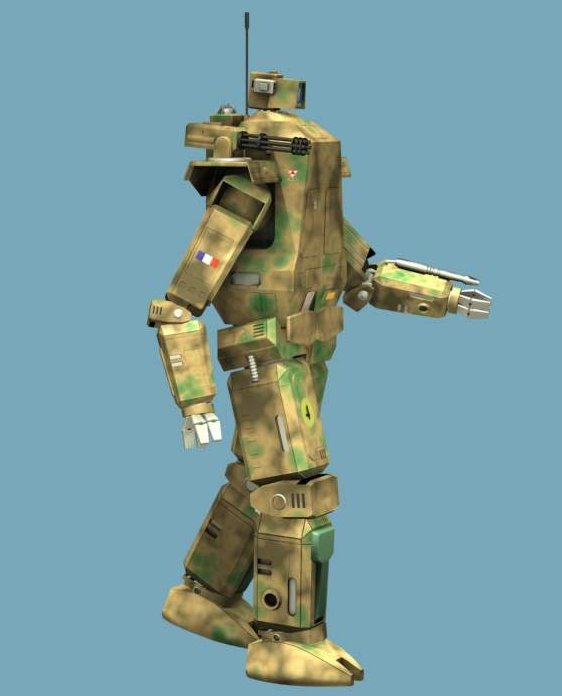
| Introduction France went into the Kafer War equipped with the 'classic' BH-21 combat walker. Unfortunately that design had already been surpassed by more modern German, British and Manchurian designs and had never really been up to competing with the Japanese state of the art. However the much more capable BH-25 was finally coming down the pipeline and was to be tested in combat by the soldiers of the elite Troupes d’ Intervention Spatiale during the Liberation of the Beta Canum Cluster. Acknowledgement Thanks to Bryn Monnery for the basic stats of the BH-25. |
| Narrative Sergent-Chef Marcotte broke from cover under heavy covering fire from what remained of the platoon. The shoulder gun buzzing rounds into the Capu troops as they spilled from the sides of the clumsy Crawlers. Marcotte dived the walker forward under the volley of return fire, something unthinkable before they had the new walkers. Her wingman was less fortunate and took the blast from the Behemoth's main armament through the breastplate. She came to he feet again, running through a clutch of Capu infantry who sprayed rounds at her. She decapitated one of them in passing and scrambled for the safety of a decrepit building. Already the Behemoth was blasting the surrounding countryside, forcing most of her troopers into cover. Only the tiny shells from a pair of obsolete mortars were still suppressing the enemy. She swivelled the shoulder gun and hosed down some of the Capu who had followed her, killing a few and forcing the rest to ground. She glanced around the corner and saw the tail end of the massive tank pass out of view. She edged around the building, priming a satchel charge as she did, catching a glimpse of the now stationary Behemoth. She pitched the charge under its rear below the troop door, then snapped back. The blast threw a wave of sound, dirt and shrapnel past her, then she moved again through the billowing smoke. The claw on her left hand yanked down the door lever, and it began to open with a hiss of hydraulics and she fumbled for the remaining charge. The compartment was full of shocked Capus who tried to scramble out of the vehicle, she gave them 200 rounds from the shoulder gun and a double tap from the arm gun which caught the first alien and sprayed the interior with plasma splash. She lobbed the charge into the steaming charnel house and ran. She made three paces when the charge detonated prematurely. She came too sprawled face down in the mud… The diagnostics showed red across the board, the VHUD was out and blood poured from a gash in her forehead. What a way to die, after three years of near misses and lucky escapes she finally was on the verge of joining her colleagues who died at Eta Bootis and in the hell of the Station Arcture… |
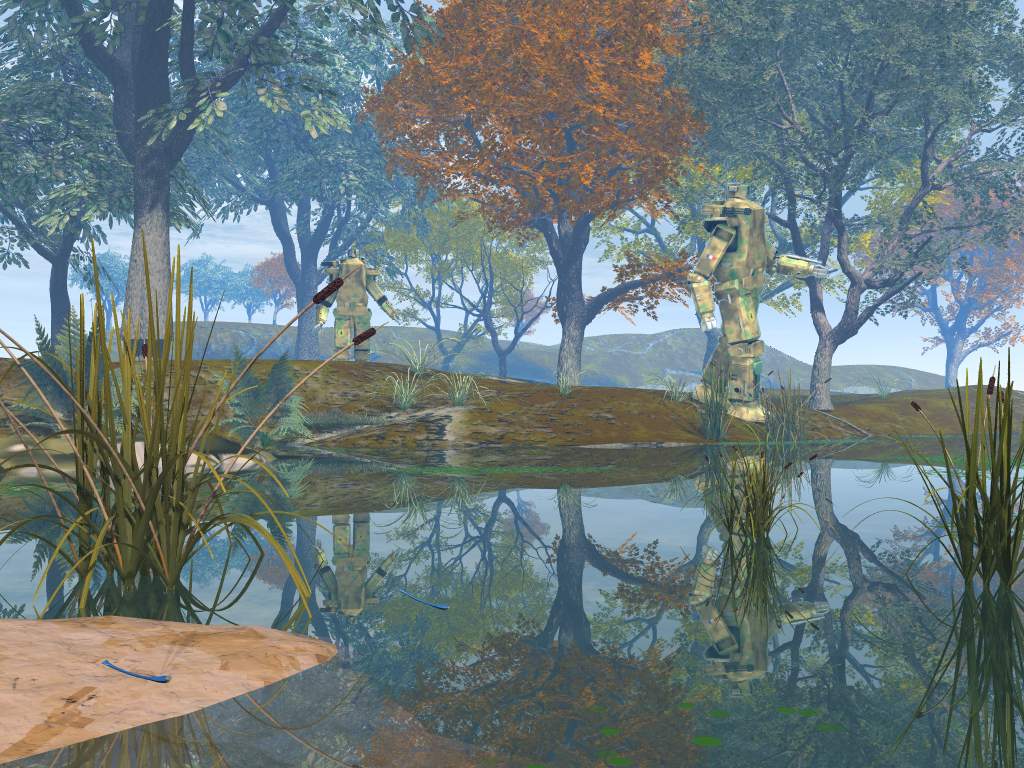
| Above:
BH-25's of I/8e RPIMa on
evaluation exercise in the west of France early in 2301.
France was one of the first nations to adopt combat walkers in large numbers, especially for urban operations and for use with specialist troops. However they have lagged behind other nations in terms of quality as a result of this policy. Combat walkers - Chasseurs a Pied Blindés (CPB) in French service - were first utilised in combat by Manchuria during the Slaver War of the 2250's and have slowly spread to the ranks of other armies. The French were one of the first western nations to begin working with combat walkers. Their initial scheme was to look at the use of walkers for off-world operations although this later spread to more conventional urban operations. This has resulted in the Troupes d' Intervention Spatiale, France's elite colonial spearhead force, having a strong backbone of CPB experience. Their role of dispersed operations and reliance on reliability has sometimes had a negative effect on the development of French walkers. The first walker to enter mainstream production was the BH-18, a lightweight walker designed with only a single medium machine gun as its armament. Designed specifically for the TIS it had a low maintenance requirement, long endurance and light armament. However with the outbreak of the Central Asian War is spread rapidly to other units. The BH-18 had its baptism of fire in the Battle of Almaty as CPB units from across the army were brought in to bolster Allied troops in combat with Manchurian stay-behind forces. The Battle of Almaty stands as one of the bloodiest episodes of the 23rd Century and the toll taken on the BH-18's was substantial, especially in elite Para units. The BH-18 frequently came into conflict with its Manchurian opposite numbers - also often in the hands of units trained for warfare in the colonies - and usually came off worse. Its armour proved utterly inadequate to defeat even infantry weapons. The French turned to an up-graded version of the BH-18, the BH-21 as a replacement. The BH-21 was an evolution of the older machine but substantially more capable, including upgraded weapons, armour and control systems. It was rushed into action in the last two years of the war. The BH-21 outclassed its Manchurian opponents in the summer of 2286, mainly because of the skill of its pilots and the new control interfaces. With casualties still at high levels the BH-21 went into mass production and rapidly re-equipped French forces in Central Asian and beyond. The BH-21's time as 'top dog' was short lived as new Bavarian, Japanese and Manchurian walkers arrived but it continued to live on its reputation for many years. The spurt of production caused by the Central Asian War gave France a huge reserve of BH-21's and whilst some were sold on to a variety of sources most were retained in storage. This glut of BH-21's led to a wave of units in France's Infantry Divisions across Earth and beyond being converted to Combat Walkers. The BH-21 became a symbol closely associated with the military Junta that took power in 2289 when BH-21 equipped units were involved in seizing control of the streets of Paris. Images of motionless BH-21's in para camouflage standing on the Champs Elysee and guarding the National Assembly from protestors were used across the world as an image of the military take-over. The BH-21 was heavily involved in the war with Germany in 2293, in bitter urban fighting on both banks of the Rhine. Although outnumbering their German opponents they frequently came off second best against the superior Kz-VII, the biggest factor being the outclassing of the mostly conscript pilots of the Infantry Divisions and poor tactical co-ordination with supporting foot soldiers. When in the hands of better trained units such as the Légion, TAP and Algerian 4e Zouaves the BH-21 could and did hold their own. French military authorities were worried by this trend but the war had brought more pressing deficiencies to light. Consequently the improvement of the combat walker fleet, which had received another influx of mass produced BH-21's was well down the list of priorities. Although the authorities were somewhat indifferent to the outclassing of France's combat walkers Automates Schneider's Brandt-Hausmann subsidiary, the manufacturers of the BH-21 were not. Especially as the availability of more advanced designs was damaging the export market for the BH-21. They started to work on a successor for the BH-21 as a private venture, putting much of the future of the company at risk. The company assembled a highly experienced test and design team, including some of the most experienced CPB pilots in the French forces. They were also given access to the French Army's Operational Research into CPB engagements. Work progressed swiftly on the new model, dubbed the BH-23, but in 2295 free market reforms brought in by the new government hit the company hard. Heavily fined for alleged corruption and monopolistic practices the company was forced to drastically cut back its R&D program and nearly went out of business. However late in 2298 the events in the Eta Bootis combined with a change in defence priorities led to the re-activation of the BH-23 programme. The BH-23 however was found to be lacking in performance when compared with more modern designs, although some were produced for testing purposes and some for export to Morocco. Instead a new model, the BH-25, was to be developed. The first prototypes of the BH-25 began testing in the first months of 2300 which revealed several problems with the chassis although these were later overcome with the use of beanstalk materials. The first production BH-25's came off the line late in 2300 and went to equip a trial company. However the Kafer Invasion led to an acceleration of the adoption process and during the summer of 2301 the I Batallion of the 8e RPIMa began to take delivery of the new CPB. An elite TIS regiment, the I/8e RPIMa, had served a year long tour on Aurore with BH-21's in 2300 and was deemed the most efficient CPB regiment in the army. They thoroughly put the new walker through its paces, investigating new doctrines and tactics specifically looking at counter-Kafer operations. This unit was the first to take the BH-25 into action, faults and all, and it is slowly replacing BH-21's on the French Arm. So far the BH-25 has proved the equal of any combat walker in front line service and is superior to most, dramatically increasing the combat effectiveness of French CPB units. (Although rumours persist of the performance of state of the art Japanese walkers now in service on Joi and Project Zerstörer, the German successor to the Kz-VII series.) Importantly for export prospects the BH-25 looks to be substantially cheaper than these (if they would ever be available) and the British Bowman. |
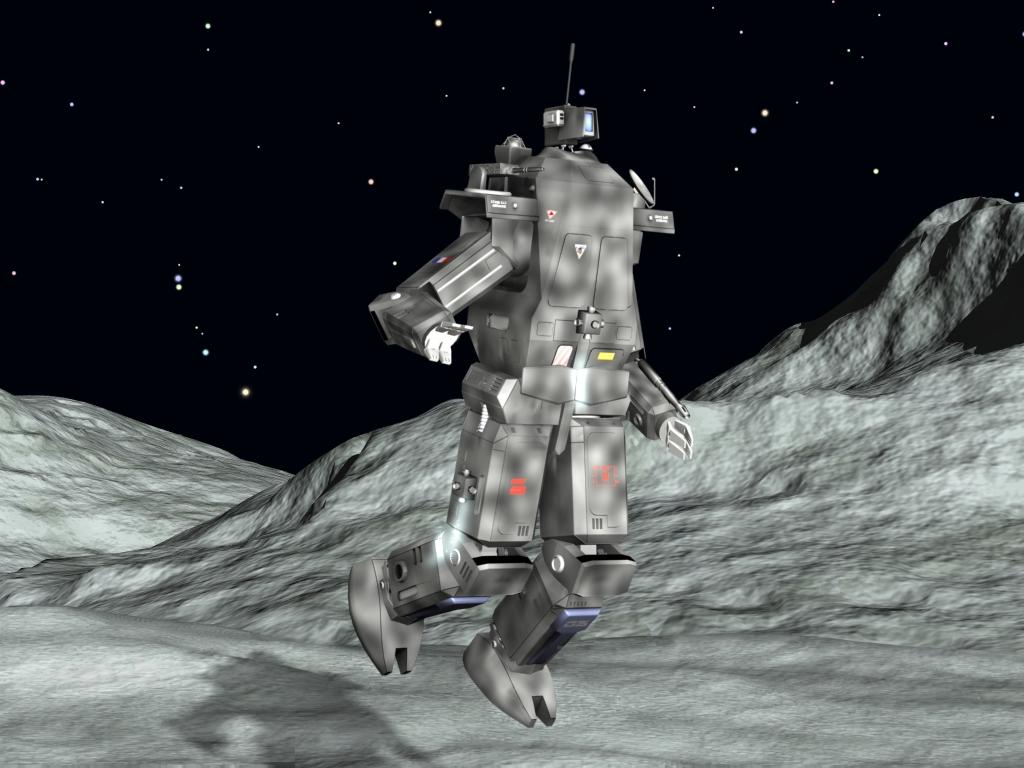
| Above:
BH-25S of II/2e REP on
operations deep in the QAS system.
The BH-25 was designed to match the mobility of the Kz-VII whilst maintaining the endurance and ease of maintenance of its predecessor the BH-21. A key design feature was an integration of armour and survivability features to ensure that the BH-25 was immune from most squad level weapon systems. Lastly in addition to an integral plasma weapon the BH-25 would have a number of modular weapons and combat support systems. The performance of the BH-25 is derived from a combined drive/suspension system based on that originally pioneered by the Japanese with their Type 0 walker and adopted by most western nations. This system, known as the Locomoteur-4B, uses several components utilising materials developed during the Beanstalk project making it more efficient to those currently utilised in German and British designs. In fact the BH-25's performance is actually limited to avoid over-stressing the chassis in day to day use but can be overridden in times of need. The BH-25 has proven itself a exceptionally nimble and is highly precise in its movements. The power train of the walker uses modular batteries loaded in the legs, although there is also a 20 minute reserve battery in the rear door. These can be rapidly replaced with fresh units by a dismounted pilot or technician, extending the operating endurance of the unit. However pilot fatigue and maintenance requirements have proven more limiting than the power system. The power train by Darlan is powerful and reliable although lacks the high end 'grunt' of that used by the British but is cheaper and easier to replace. The walker utilises a single sensor turret mounted as a 'head' on the top of the chassis, should this be knocked out the pilot can raise an armoured visor covering a window allowing him some vision from the front. The sensor turret, manufactured by Darlan Optronics, includes a full range of sensors. These include visual sensors with magnification up to 60x, coupled with thermal and other optical enhancement devices. Radar and Lidar systems are also included. The head unit feeds data into a processor mounted in the hull of the walker which is where most of the expensive equipment is located. The head units are modular and swiftly changed if damaged. Communications, always a weak point with the BH-21 have been a key feature of the design process with the new walker. Adapted by Brandt Electronique from their ACVI and VCIR VBE comms suits the BE-11 is a highly secure system with a range of up to 230 km, and also has a HF function capable of much greater range. The suit can operate on multiple nets simultaneously as well as functioning as a datalink. With the addition of the SCS antenna package on one of the walkers shoulder hard-points the suit can broadcast (it can already receive) to orbiting satellites or starships. The suite also has an impressive EW capacity, rivalling that carried on specialist vehicles. The control system of the BH-25 has been produced in house by Automates Schneider and consists of a number of control modules dispersed around the walker and controlled through a central processor located in the rear door of the walker. This central unit is modular and is easily replaced if damaged and although it lacks redundancy it does not require the lengthy calibration of the Black Arrow system used on the Bowman. AS is currently in dispute with Canadian firm NeuralNet who claim they used several systems and subroutines (developed by NN for the BH-21 for service with the US) without permission. A major law suit looks likely to occur with both sides not budging. The armour system on the BH-25 is one of its major features and renders it safe from most direct fire weapons carried by conventional infantry troops. Although the composition of the armour plate remains classified it is fair to speculate that it is composed of modern composites and alloys. The design included many measures to enhance the vehicle's resistance to detection, although the French realise that some more esoteric stealth techniques are of limited use in high intensity conflicts and so have not included them in the design. Nevertheless the BH-25 has a cost effective system of thermal damming and a low radar cross section, supplementary visual/thermal physical camouflage can also be attached to the vehicle. All BH-25's have provision for parachute operations and lower limb bracing to lessen the landing stresses. There is only one integral weapon system, the tried and tested Quinn-Darlen M4A1, a 20MW plasma weapon first mounted on the BH-21. On the BH-25 this weapon is also arm mounted and provides the vehicle with anti-infantry and anti-vehicle firepower. It has proved highly reliable with the BH-21 and should also prove so with the BH-25. One of the main advances over previous French walkers has been the provision of modular weapons packages. Previously the BH-21 required extensive modification to carry jury-rigged weapon systems and few of these proved reliable or particularly effective. Now a number of weapons (and systems) packages have been developed, or are in development, for use. These currently include a multi-barrel gauss machine gun, close protection grenade launchers, a rapid fire laser package and a firing post for the Blindicide-9 anti-tank system. Also in development are a modification of the heavy Manta-1 ATGW, a Martel based SHORAD system and a light mortar carrier to name but a few. The BH-21 was perhaps notorious most of all for its sluggishness and slowness when compared with other walkers. This was partly due to the position in which the pilot sat and the relative age of the control system which required heavy gyros. Although this had some advantages, pilots had more comfort and endurance and the BH-21 was a very stable gun platform, they were substantially outweighed by the disadvantages. In the BH-25 the pilot stands up in the walker and has his arms inside the upper arms with waldo gloves on to utilise the functionality of the hands. The pilot is clad in combat equipment (due to cooling problems BH-21 pilots often wore only shorts and t-shirts, hardly practical military dress) and enters the walker through the rear door. There has been a requirement for the pilot to be able to mount the walker and bring it up to operation without the aid of an assistant. This has largely been met and the start up times are much improved on the 15 minutes of the previous walker. A major problem has been the lack of space for the pilot's personal equipment and weapons, consequently many pilots attach a small escape rucksack to the outside of the rear door. The pilot views his world through the sensors of his walker. These are projected by a 3D holo system by Brandt in front of his face, should it fail the pilot has a standard window behind an armour plate to fall back on. This VHUD is fully customisable by the pilot. Below: Screen shot of the VHUD of a BH-25. Although actually taken from a simulator on Earth it is running an Aurore operations simulation. |
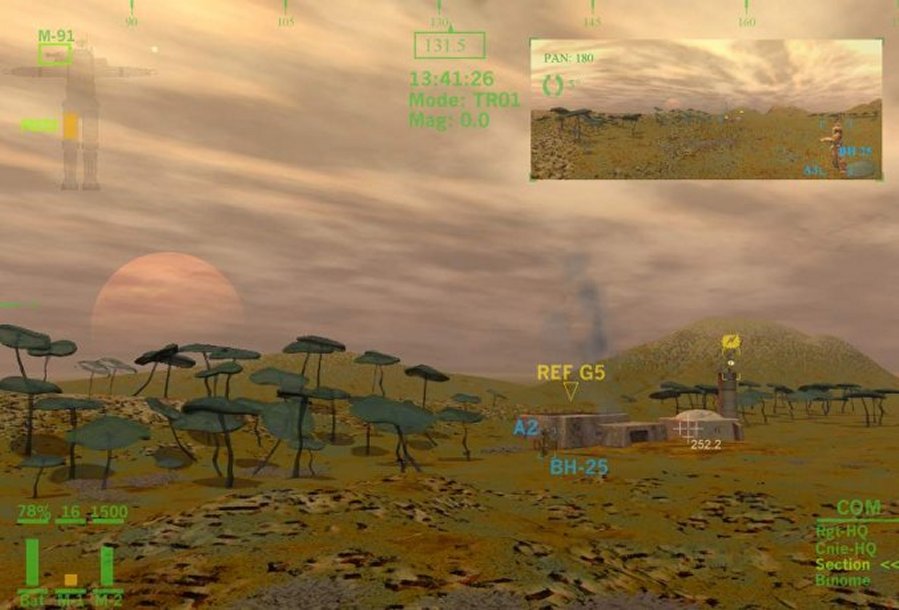
| Combat
History The first operational use of the BH-25 came during Operation Entente, the evacuation of Kimanjano, early in 2302. Two battalions of paratroopers (one French, one British) were used to buttress the collapsing perimeter around the Landing Zones. The 3e Compagnie of the I/8e RPIMa, newly arrived in theatre, was attached to its sister battalion II/8e RPIMa along with a company of BH-21's from the II/2e RPIMa. The company was under the command of the II/8e RPIMa's EMT 2 along with two rifle companies and support elements and was responsible for covering the southern approaches to the perimeter. Although drop capable they were deployed from the IFS Verdun by lander and took over defensive positions within a trio of villages from a badly depleted Colonial Infantry battalion. This ground provided ideal ground for EMT 2, unlike EMT 1 which faced heavy armoured attacks over relatively open ground. The 3e Compagnie suffered nearly 33% casualties in its 25 hours on the ground, loosing 6 walkers to enemy action and 3 pilots killed, but was forced to abandon and destroy a further 5 BH-25's when there was no room in the evacuating landers for them. The company was largely used as a reserve force, moving forward to counter-attack Kafer incursions and then as a rearguard covering the evacuation of the rifle companies. The mobility, firepower and protection of the BH-25's was clearly superior to that of the older walkers and the EMT 2 commander, Commandant Baltzer soon started to rely on it. The inability of Kafer soldiers to stop the rampaging counter-attacks of the BH-25's gave his unit a major morale boost during the fighting. The combat debut of the BH-25 was regarded as being very promising, especially when compared with the BH-21 casualties with the II/8e RPIMa's EMT 1. However the priority for unit conversion was given to special forces and at the time of the Battle of Beowulf only the II/2e RPIMa had any BH-25's and of those only a company had finished the change over. The entire I/8e RPIMa was committed to the Liberation of Kimanjano with the 2e Brigade d' Intervention whose mission was to seize and hold key choke points leading to the Landing Zones. Should they fail in this they were to harass any movement along these routes. The I/8e RPIMa, reinforced with a company of the 1/ Régiment Para-Commando was to hold the Route Coloniale 2 where it passed through the town of Galliarde-sur-Maine where it was to relieve the Groupement Étranger de Choc that was to land in advance. The fight in Galliarde was one of horrendous ferocity. Dropping in capsules from the IFS Bir Hakeim the battalion landed in the middle of a firefight. The convict légionnaires of the GEC were already deep in combat with the Kafer garrison whilst trying to block the progress of an armoured column traversing the town. In a fight lasting three hours the mixed force of I/8e RPIMa, GEC and guerrillas of the Francs-Tireurs de Kimanjano battled for control of Galliarde. However by the end of the day the arrival of reinforcements including thousands of Kafer troops and Behemoth heavy tanks had driven through the town and pushed the battalion back into the suburbs. Casualties had reached 50% in the battalion, civilian fatalities ran into thousands, but they had imposed a vital delay on the Kafer counter-attack, which was compounded by other elements of the brigade. Over the next three days the battalion continued to launch attacks onto the RC-2, although an attempt to blow the pontoon bridge over the Maine failed. Surprisingly Kafer counter attacks into the human perimeter were consistently ineffective, the usefulness of the BH-25's sensors in spotting infiltrating Kafer infiltrators was proved again and again. The battalion's ordeal at Galliarde was finally ended when the lead elements of the 2e Division de Marche Coloniale reached the town after the break-out. Along with the rest of the 2e BI, the battalion had suffered heavy casualties with fewer than 25% of the BH-25's that survived the drop being on their feet when the unit was relieved. However pilot casualties were much lower and the battalion was soon combat effective once more. I/8e RPIMa would then take part in numerous actions in support of the mobile divisions as there was only a limited number of light infantry units available for action on Kimanjano. However two months into the fighting with increasing numbers of regularised FTK battalions becoming available the brigade was withdrawn for refit. The only BH-25's involved in the 3rd Liberation of Beta Canum 4 belonged to a single company (5e Escadron) of the 1e Régiment de Hussards Parachutiste of the famous 11e Division Parachutiste. The division's two dedicated CPB battalions were still being equipped with BH-21's. The French Armée de Libération placed relatively little importance on Beta Canum operations, believing the planet to have been effectively Liberated by troops landed by Admiral Rochemont's Fleet. As a consequence of this and the heavy commitment to the fighting on Kimanjano relatively few French troops were committed to the initial operations. The 11e DP landed in the second wave and was heavily engaged in the liberation of Premiere alongside French units that survived the invasion and had to be supported by British, German and Commonwealth forces before the arrival of reinforcements from 2e Corps. 5e Escadron was involved in a pathfinder role for the 11e DP, as General de Division Micheletti attempted to use as much manoeuvre as possible to break up Kafer concentrations, although the unit was of too small a size to have much influence on the outcome of the campaign. A similar number of BH-25 from the 13e Régiment de Dragons Parachutiste were involved as pathfinders in the Liberation of Nous Voila in the BCB system. Since the end of the major Liberation campaigns three of the four CPB battalions attached to the TIS have been re-equipped with BH-25. Only the Légion's II/2e REP has yet to complete conversion but currently has one company re-equipped, notably it is the orbital specialist 1e Compagnie with the first production BH-25S. The battle hardened Régiment de Parachutistes Coloniaux, de-facto the 5e Brigade d' Intervention, has recently converted its III Batallion to the CPB role and has been equipped with BH-25 from the start. Other units are slowly receiving the new walker once the TIS and special forces have been equipped. Below: The lead elements of I/8e RPIMa cross Galliarde-sur-Maine's Place de l'Atlas. (Image taken from the helmet camera of a trooper from 1/Para-Cdo.) |
.jpg)
| Organisation The order of battle for a BH-25 unit is currently identical to a BH-21 equipped one. The typical combat walker battalion is organised into 4 CPB companies (Compangnie de Chasseur à Pied Blindés, CCPB) and one CCS (Compagnie de Commandement et des Services). The battalion currently relies on brigade for specialised reconnaissance and support, but there are plans to form integral support companies (CEA - Compagnie d' Éclairage et Appui) in the near future using converted BH-25's. The CCS combines the usual elements found in such a formation, and the supply platoon normally holds 25 extra CPB for replacement purposes. A tactical HQ, with commanding officer, second in command, adjutant and regimental sergeant major are equipped with BH-25, but are more often transported by the ubiquitous ASL-12 ACV jeep. Each CCPB has an HQ and support platoon which includes a maintenance section to keep the sometimes unreliable CPB in service, and two platoons of CPB for a total strength of 24 BH-25. The company tactical HQ includes the company commander, his second in command, the sergeant major and a guard, all mounted on BH-25. The platoons are commanded by a Lieutenant and Sergent-Chef, and have two sections for a total of ten CPB. The section has two teams each of two BH-21, the first is led by a Sergent (Chef de groupe) who commands both his team and the section and the second team by a Caporal-Chef (Chef d' équipe). The remaining pilots (also known as Chasseurs à Pied Blindés) are privates or junior NCO's. Below: Organisation diagram for a standard CPB platoon.
|
| Stats There are only two models of BH-25 in production. The baseline BH-25 and the modified zero-G/vacuum BH-25S. The modular nature of the BH-25's weapons means that the weapon system is inherently flexible. French BH-25 Combat Walker The BH-25S, for Spatial, has been introduced as an urgent operational requirement to replace the BH-21C previously used in the role. It has the usual range of modifications including extended life-support and radiation shielding, enhanced comms system and zero-G manoeuvre system based on the EEOS of the BH-21C. The BH-25S has the usual shoulder hard points and can carry any of the weapons packages utilised by the normal model, although typically laser weapons are favoured to lessen the problems of recoil. Weapons: Listed below are some of the more common weapon packages currently in service, although many more are in development. Quinn-Darlan M4A1 PGCW The M4A1 is a tried an tested design of exceptional reliability for a plasma weapon. It is mounted in the left arm of the walker. The BH-25 has an ammunition capacity of almost double that of its predecessor. As the weapon is a variant of the M4 PGMP used by French and American squads cells are in ready supply. Type: 20 MW combat walker mounted plasma gun Country: France/USA Action: Single shot, Ammunition: 17x91mm 20 MW photonic core plaser cell, Ammunition weight: 0.8 kg Magazine: 60 round internal magazine, ROF: 1, Aimed Fire Range: 1700m, DPV: As tamped explosion (EP = 4), Ammo price: Lv 18 per cell. Manufacture d'Armes de St Etienne, Mitrailleuse pour Chasseur à Pied Blindée Mk.91 - MAS MCPB-91 The MCPB was developed in response to complaints about the limitations of the BH-21 when faced by Kafer 'wave' assaults. The six barrelled weapon, usually mounted on the right shoulder, has an exceptionally high level of fire ideal for the suppression of enemy infantry, although it is worthless against armoured vehicles. It has also proved itself capable of downing enemy ATGW in point defence mode. It is known by the troops as 'la sulfateuse'. Type: 7.5mm vehicle mounted multi-barrelled gauss machine gun Country: France ROF:5, Aimed Fire Range: 1000m, Area Fire Burst: up to 300 rounds (AFV:30), Area Fire Range: 800m, DPV: 0.8. Magazine: 3000 rounds. Guiscard, Système Anti Char-9 pour CPB - SAC9-CPB A conversion of the Blindicide-9 currently in service with the French infantry. Modified for carriage on the BH-25 it allows the vehicle to take on light AFVs. It is know as the 'l'ouvre-boîtes' or the 'can opener'. The system includes a magazine of no fewer than 9 rounds. The arrival of a single SAC9 equipped BH-25 can substantially boost the firepower of any unit. Type: Light anti-vehicle missile Nation: France, Launcher weight: 12kg, Missile weight: 3kg, Range: 1500m Guidance: Automatic following gunner lock on, Homing value: 14 Attack angle: selectable Damage: As tamped explosion (EP = 25) Price: Not available, Magazine: 9 rounds. Anti-Personnel Grenade System This shoulder mounted pack involves an array of 30mm rifle grenades in pre-packed tubes that cover a 90 degree arc around the walker. These have a range out to 100 meters and can saturate and area with shrapnel with ease. French Combat Walker Pilots French CPB pilots from the TIS will generally be of veteran or elite NPC status in ground military. Those from the TAP will usually be veterans. Regular pilots from Metropolitan or Colonial armies will generally be experienced NPCs. Those conscript pilots in the forces protecting mainland France will mostly be green. French special forces equipped with CPB's will be elite and highly experienced. As will the crack teams from the MSIF's Fusiliers-Voltigeurs Marins Spatial (FULVOLMARS) who are converting to the BH-25S Below: Close up of Lt Alain Didier of 13e RDP on patrol in a relatively untouched part of Nouvelle Amman. Note that the pilot has his visor open, part of doctrine for relief operations, and the presence of a relief program Zep in the distance. |
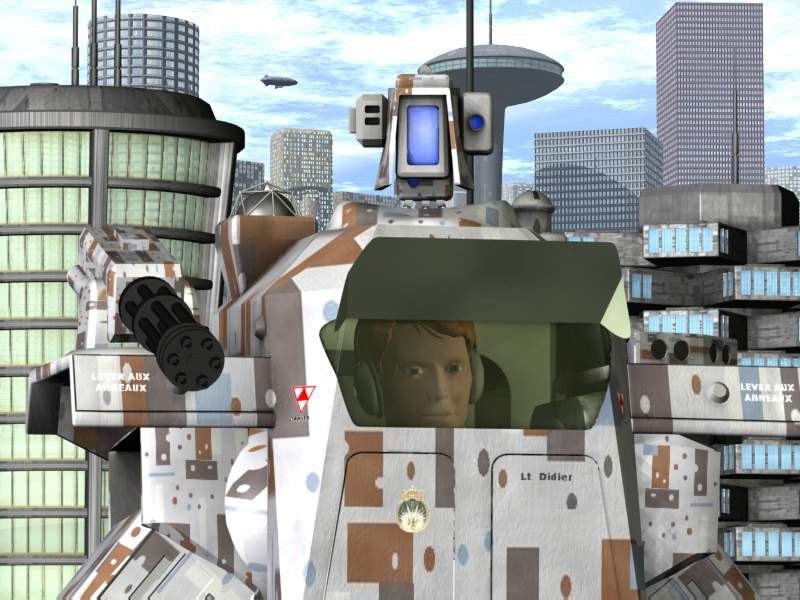
| Colour
Plates The French have always used camouflage schemes on their CPB's and these have been swiftly adopted for use with the BH-25. Included below are some key examples in use with TIS units on the French Arm. |
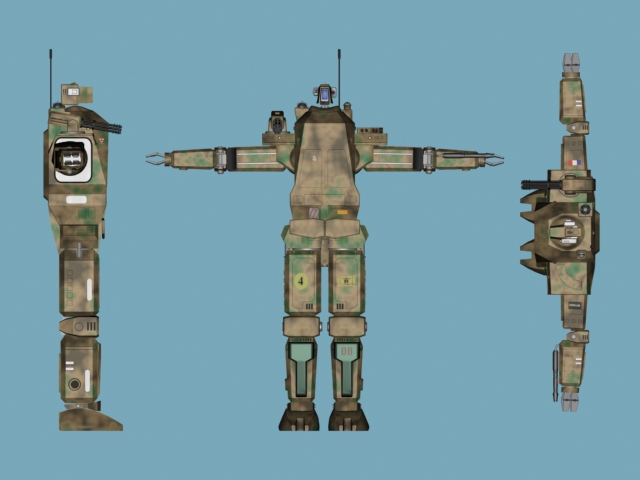
| BH-25, 3e Compagnie, I Bataillon, 8e
Régiment Parachutiste d' Infanterie de Marine -
Kimanjano - January 2302 This picture shows the standard temperate pattern, here shown on a CPB belonging to the I/8e RPIMa during Operation Entente. This particular CPB survived both Entente and the Liberation of Kimanjano, although it was badly damaged in Galliarde-sur-Maine. This pattern was applied using the standard BH-21 template and seemed to work quite well. As such it is a baseline pattern for new BH-25's delivered to the French Arm. |
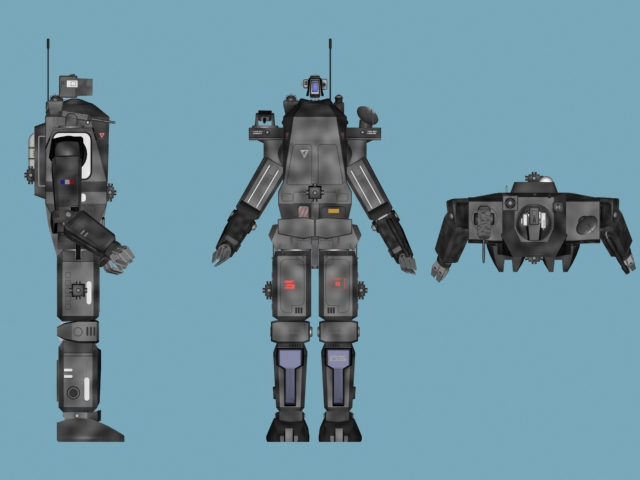
| BH-25S, 1e Compagnie, II Bataillon, 2e
Régiment Etranger de Parachutiste - Queen
Alice's Star - February 2302 This CPB is detailed in the orbital operations scheme currently used on BH-25S deployed with the II/2e REP and the FULVOLMARS of the MSIF. Notable are the hardpoint combination of the LA-2 laser system and the SCS 'Système de Communication Satellitaire' known to the pilots as 'La poêle' or the 'frying pan.' The 1e Compangnie of II/2e REP has yet to use its BH-25S in anger, although it has undertaken numerous exercises in the QAS system whilst the rest of the brigade re-organises and re-equips. Rumours persist that the unit will deploy to the Eta Bootis Finger towards the end of 2303. |
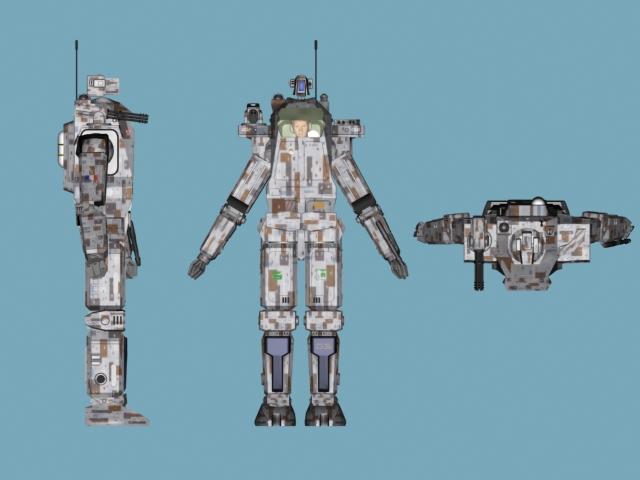
| BH-25, 2e Escadron, 13e Régiment Dragons
Parachutiste - Nous Voila - September
2302 13e RDP were involved in the 'Liberation' (as there were no Kafers on world) of Nous Voila, an operation that was largely a humanitarian operation trying to restore the world to normality. 13e RDP's 2e Escadron was tasked for the liberation of the capital and so was given this striking urban combat scheme. 13e RDP were largely used as a fire brigade trying to suppress marauders and restore order on Nous Voila and were withdrawn before the end of 2302. Elements are now deployed on Aurore. |
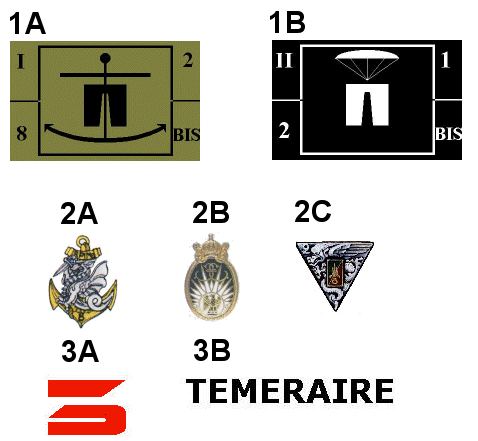
BH-25's carry a minimum of tactical insignia, usually only a single battalion insignia which identifies both the unit and parent brigade. 1A shows that used by the I/8e RPIMa and 1B that of II/2e REP. In addition to the ubiquitous national insignia almost all CPB carry the regimental insignia. In this example of 8e RPIMa (2A), 13e RDP (2B) and 2e REP (2C). Less formal insignia include a red '3' (3A) which signifies the 3e Equipe of 2e Pl of II/2e REPs 1e Cie, and the names (3B) carried by individual CPB in I/8e RPIMa.
|